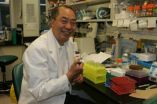(Press-News.org) CAMBRIDGE, Mass. (July 17, 2014) – A signaling pathway once thought to have little if any role during embryogenesis is a key player in the formation of the front-most portion of developing vertebrate embryos. Moreover, signals emanating from this region—referred to as the "extreme anterior domain" (EAD)—orchestrate the complex choreography that gives rise to proper facial structure.
The surprising findings, reported by Whitehead Institute scientists this week in the journal Cell Reports, shed new light on a key process of vertebrate embryonic development.
"The results are exciting on a number of levels," says Whitehead Member Hazel Sive. "We uncovered two new and important things about facial formation, and it turns out they tie together."
Sive and her lab have long been using the frog Xenopus as a model in which to study development of the EAD into the mouth. Several years ago, Amanda Dickinson, a postdoctoral researcher at the time, and Sive showed that the Wnt signaling pathway, which is active throughout the body in a wide array of developmental processes and in cancer, is vital for mouth formation. At the time, they observed that frog embryos whose Wnt signaling was disrupted only in the EAD not only failed to develop mouths, but also experienced other facial abnormalities. This suggested that the EAD may act on adjacent regions as a craniofacial "organizer" or signaling center.
Intrigued by this possibility, the lab searched for regulatory factors in the EAD that could affect craniofacial formation as a whole. Microarray analysis pointed to three highly expressed genes that also happen to be active participants in the Kinin-Kallikrein signaling pathway, best known in humans for its roles in regulating blood pressure, inflammation, and kidney function.
"We had no inkling that this pathway was active in the embryo," says Sive.
The lab confirmed its findings through a series of loss-of-function (LOF) experiments in which they knocked out the expression of each of the three genes in developing embryos and observed the effects. In all cases, the facial regions displayed significant defects, ranging from a lack of a mouth opening to the absence of nostrils to abnormally small eyes. In addition, the migration of the neural crest, whose cells give rise to the nerves, cartilage, bones, and other components of the face, failed to occur normally.
Because the expression of two of the pathway genes yields the peptide Bradykinin, the researchers theorized that introducing Bradykinin into LOF embryos at the appropriate stage would allow them to develop normally. They implanted tiny beads soaked with Bradykinin peptides, rescuing not only mouth formation but also proper neural crest development. The Kinin-Kallikrein pathway ultimately produces the signaling molecule nitric oxide (NO). Not surprisingly, the scientists found reduced NO levels in their LOF embryos. As they predicted, peptide-soaked beads led to an increase in NO production, further confirming the role of the pathway and its genes during facial formation. Importantly, NO had not been thought critical for development of this region.
Finally, in an effort to determine whether the requirement for Kinin-Kallikrein signaling in craniofacial development is conserved, Sive lab graduate student Justin Chen turned to LOF experiments in zebrafish. They found one of the pathway genes to be necessary for proper formation of both the mouth and the neural crest.
"This study greatly enhances our overall view of craniofacial development," says Laura Jacox, a graduate student pursuing a dual DMD-PhD degree through the Harvard School of Dental Medicine and the Harvard-MIT Health Sciences and Technology program. "Knowing what tissues are communicating with each other may help us determine where we could intervene to prevent or treat developmental abnormalities of the face."
Jacox is co-first author of the Cell Reports paper along with postdoctoral researcher Radek Sindelka, who now heads a research group in Prague, Czech Republic.
It is unclear whether similar mechanisms are at play in mammals, including humans. Sive, however, hints that there may be a connection. She notes that certain blood pressure medications, which act on parts of the Kinin-Kallikrein pathway, can cause severe craniofacial defects in newborns if taken during pregnancy. Although such defects have been attributed to effects mediated by the kidneys, Sive's latest findings may implicate Kinin-Kallikrein signaling.
INFORMATION:
This work is supported by the National Institute of Dental and Craniofacial Research (grants 1R01 DE021109-01 and F30DE022989) Harvard University's Herschel Smith Graduate Fellowship.
Written by Matt Fearer
Hazel Sive's primary affiliation is with Whitehead Institute for Biomedical Research, where her laboratory is located and all her research is conducted. She is also a professor of biology at Massachusetts Institute of Technology.
Full Citation:
"The Extreme Anterior Domain Is an Essential Craniofacial Organizer Acting through Kinin-Kallikrein Signaling"
Cell Reports, July 17, 2014
Laura Jacox (1,2,3,4,5), Radek Sindelka (1,6), Justin Chen (1,2) Alyssa Rothman (1), Amanda Dickinson (1,7) Hazel Sive (1,2)
1. Whitehead Institute for Biomedical Research, Cambridge, MA 02142, USA.
2. Department of Biology, Massachusetts Institute of Technology, Cambridge, MA 02139, USA.
3. Harvard School of Dental Medicine, 188 Longwood Ave, Boston, MA 02115 USA.
4. Harvard Medical School, 250 Longwood Ave, Boston, MA 02115 USA. 5. Harvard Graduate School of Arts and Sciences, 1350 Massachusetts Avenue, Holyoke Center 350, Cambridge, MA 02138 USA.
6. Present address: Institute of Biotechnology, Videnska 1083, Prague 4, 14220, Czech Republic.
7. Present address: Virginia Commonwealth University, 1111 W Broad St, Richmond, VA 23220 USA.
A region and pathway found crucial for facial development in vertebrate embryos
2014-07-17
ELSE PRESS RELEASES FROM THIS DATE:
Tak Mak study in Cancer Cell maps decade of discovery to potential anticancer agent
2014-07-17
(TORONTO, Canada – July 17, 2014) – The journal Cancer Cell today published research led by Dr. Tak Mak mapping the path of discovery to developing a potential anticancer agent.
"What began with the question 'what makes a particular aggressive form of breast cancer cells keep growing?' turned into 10 years of systematic research to identify the enzyme PLK4 as a promising therapeutic target and develop a small molecule inhibitor to block it," says Dr. Mak, Director of The Campbell Family Institute for Breast Cancer Research at the Princess Margaret Cancer Centre, University ...
Gender quotas work in 'tight' cultures, says new paper from the University of Toronto
2014-07-17
Toronto – Quotas probably won't get more women into the boardroom in places like the U.S. and Canada.
They have a better chance however in countries such as China or Germany where people place a higher value on obeying authority and conforming to cultural norms, say a pair of researchers at the University of Toronto's Rotman School of Management. Their conclusions are published in the journal Organizational Dynamics and in a blog for the Harvard Business Review.
It all comes down to a culture's "tightness" or "looseness" -- the degree to which a culture maintains social ...
A new view of the world
2014-07-17
New research out of Queen's University has shed light on how exercise and relaxation activities like yoga can positively impact people with social anxiety disorders.
Adam Heenan, a Ph.D. candidate in the Clinical Psychology, has found that exercise and relaxation activities literally change the way people perceive the world, altering their perception so that they view the environment in a less threatening, less negative way. For people with mood and anxiety disorders, this is an important breakthrough.
For his research, Mr. Heenan used point-light displays, a depiction ...
Transplant patients who receive livers from living donors more likely to survive
2014-07-17
(PHILADELPHIA) – Research derived from early national experience of liver transplantation has shown that deceased donor liver transplants offered recipients better survival rates than living donor liver transplants, making them the preferred method of transplantation for most physicians. Now, the first data-driven study in over a decade disputes this notion. Penn Medicine researchers found that living donor transplant outcomes are superior to those found with deceased donors with appropriate donor selection and when surgeries are performed at an experienced center. The ...
GW researcher unlocks next step in creating HIV-1 immunotherapy using fossil virus
2014-07-17
WASHINGTON (July 17, 2014) — The road to finding a cure for HIV-1 is not without obstacles. However, thanks to cutting-edge research by Douglas Nixon, M.D., Ph.D., and colleagues, performed at the George Washington University (GW), Oregon Health & Science University, the University of Rochester, and UC San Francisco, the scientific community is one step closer to finding a viable immunotherapy option for HIV-1, using an immune attack against a fossil virus buried in the genome.
A major hurdle in eradicating HIV-1 has been outsmarting the frequent mutations, or changing ...
Oregon geologist says Curiosity's images show Earth-like soils on Mars
2014-07-17
EUGENE, Ore. -- Soil deep in a crater dating to some 3.7 billion years ago contains evidence that Mars was once much warmer and wetter, says University of Oregon geologist Gregory Retallack, based on images and data captured by the rover Curiosity.
NASA rovers have shown Martian landscapes littered with loose rocks from impacts or layered by catastrophic floods, rather than the smooth contours of soils that soften landscapes on Earth. However, recent images from Curiosity from the impact Gale Crater, Retallack said, reveal Earth-like soil profiles with cracked surfaces ...
Is the universe a bubble? Let's check
2014-07-17
Never mind the big bang; in the beginning was the vacuum. The vacuum simmered with energy (variously called dark energy, vacuum energy, the inflation field, or the Higgs field). Like water in a pot, this high energy began to evaporate – bubbles formed.
Each bubble contained another vacuum, whose energy was lower, but still not nothing. This energy drove the bubbles to expand. Inevitably, some bubbles bumped into each other. It's possible some produced secondary bubbles. Maybe the bubbles were rare and far apart; maybe they were packed close as foam.
But here's the thing: ...
Orthopedic surgery generally safe for patients age 80 and older
2014-07-17
ROSEMONT, Ill.─Over the past decade, a greater number of patients, age 80 and older, are having elective orthopaedic surgery. A new study appearing in the Journal of Bone and Joint Surgery (JBJS) found that these surgeries are generally safe with mortality rates decreasing for total hip (THR) and total knee (TKR) replacement and spinal fusion surgeries, and complication rates decreasing for total knee replacement and spinal fusion in patients with few or no comorbidities (other conditions or diseases).
"Based on the results of this study, I think very elderly patients, ...
Study led by indigenous people uncovers grizzly bear 'highway'
2014-07-17
A novel, First Nations-led research collaboration has revealed a previously undocumented grizzly bear aggregation in coastal British Columbia, one of the most southerly aggregations of salmon-feeding grizzlies in North America. Using non-invasive DNA analysis, the authors describe a grizzly bear "highway," identifying nearly 60 individual bears, many who travelled hundreds of miles from surrounding areas to feed on autumn-spawning salmon in the Koeye River. The research was guided by the customary law and cultural practices of the Heiltsuk First Nation and recently published ...
Lipoic acid helps restore, synchronize the 'biological clock'
2014-07-17
CORVALLIS, Ore. – Researchers have discovered a possible explanation for the surprisingly large range of biological effects that are linked to a micronutrient called lipoic acid: It appears to reset and synchronize circadian rhythms, or the "biological clock" found in most life forms.
The ability of lipoic acid to help restore a more normal circadian rhythm to aging animals could explain its apparent value in so many important biological functions, ranging from stress resistance to cardiac function, hormonal balance, muscle performance, glucose metabolism and the aging ...






